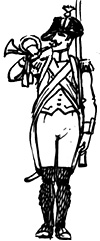 David Bates and I had a full days' Napoleonic battle last weekend to try a
new scheme for Orders.
David Bates and I had a full days' Napoleonic battle last weekend to try a
new scheme for Orders.
Briefly, there is a two-level system of orders (all written) Battalion commmanders can only issue the orders Halt, Form Square, Form Line, Form Column, Skirmishers Out, Skirmishers In, Lie Down, Rise. Only Corps commanders (6 each side in the battle we fought) can give more general orders, e.g., orders to change direction, and each Corps commander can only give each such order per move, to a unit within 3". Once a unit has started moving, it keeps going until its Battalion commander calls a halt -- and then requires a further Corps commanders order to set off again.
The idea is to restrict the speed with which groups of battalions can react to a new situation.
We tried a scaled-down version (6 times down) of Austerlitz. Thus, we had about 12,000 troops each on a 1.5 mile front (we use 20 men = 1 figure; 25 yards = 1 inch).
To offset the numerical superiority of the Allies, (Infantry 11,740 to 10,240, Cavalry 2,600 to 2,040, Guns 48 to 24) the French were given two advantages. First, they were allowed an active Commander-in-Chief (Napoleon figure) who could give 2 orders per move (the Allies had no active Commander-in-Chief) to units within 6". Second, for the first 6 moves, the 18" of the table on the French side (i.e. up to the lower slopes of the Pratzen plateau) are enshrouded in mist, so that the French can form their attack essentially unseen.
I wrote the rules and always play 'French'!
Knowing David would probably sit doing nothing until the mist rose, I turned Napoleon's plan upside down and threw all my cavalry at his weak point - the gap between Kienmayerr's troops and the troops at the South of the plateau. He partly anticipated this, but even so, I drove his left-hand corps into the marshes at move 9, due mainly to Napoleon's direct handling of the cavalry and the inability of the Allied cavalry to get into position quickly. The French main thrust was a 'right hook' with 3/4 of the infantry and guns and though we had to call halt before a final decision was reached (with the main forces locked in melee on the top of the Pratzen). I had captured 8 of his guns and destroyed another 10 for the less of only 2 and had virtually levelled up the numerical strength. I could say, as did Napoleon, "The battle is won, but there is still a lot of hard fighting to do."
The game did not move as quickly as we had hoped, and we have several ideas for speeding things up, without resorting to the too-fickle dice (we only used dice in melees, and then only in a minor way).
One of these days we will have a set of rules which is both realistic and playable (and I am not going to put down here what I mean by realistic).
We were both happy with our two-level order system, and it certainly restricted the speed of reaction.
Did you see in 'Tradition', Ney took one full hour to get his cavalry together before the famous charge at Waterloo?
Back to Table of Contents -- Wargamer's Newsletter # 102
To Wargamer's Newsletter List of Issues
To MagWeb Master Magazine List
© Copyright 1970 by Donald Featherstone.
This article appears in MagWeb.com (Magazine Web) on the Internet World Wide Web.
Other articles from military history and related magazines are available at http://www.magweb.com